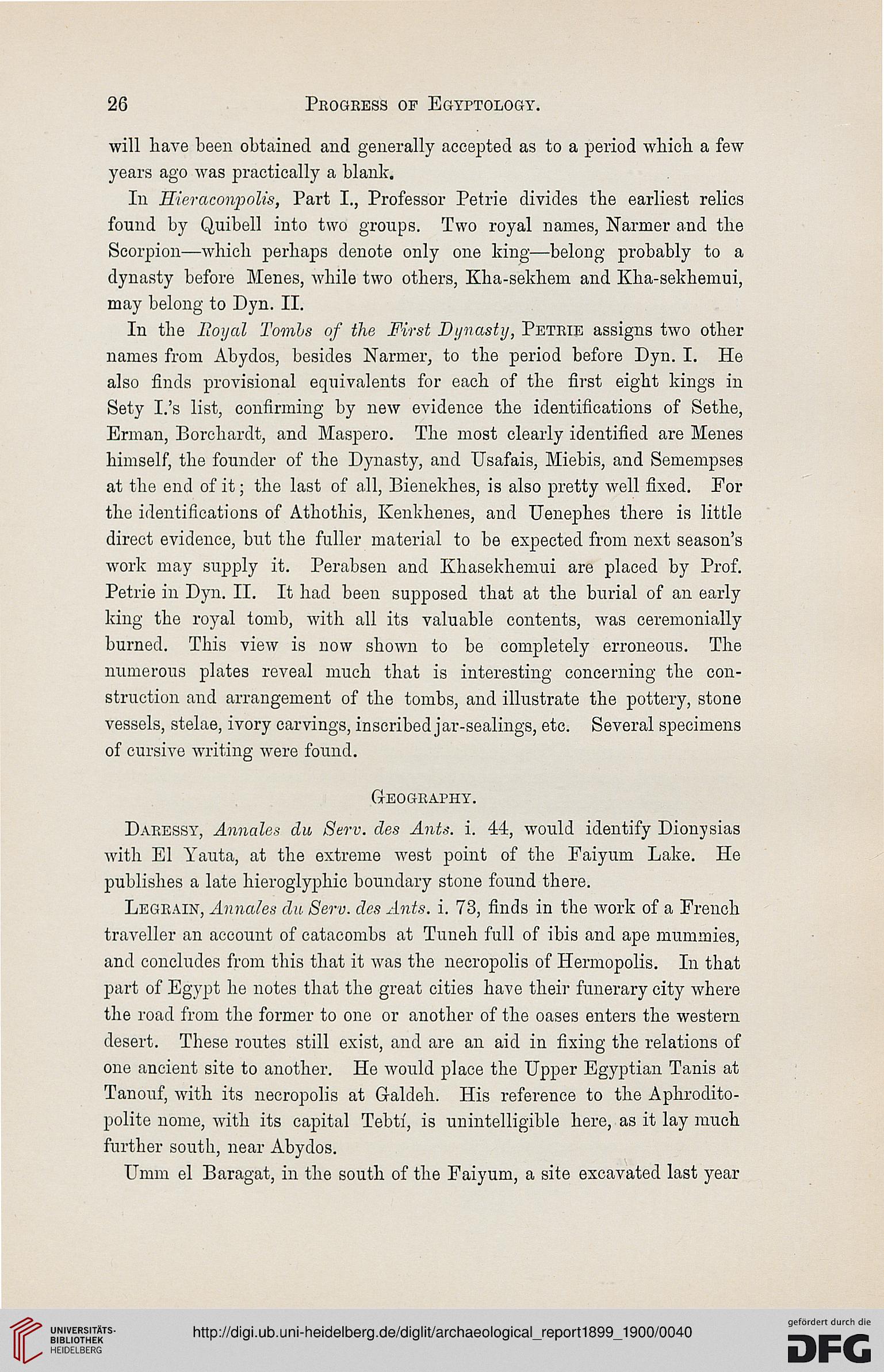2G
Progress of Egyptology.
will have been obtained and generally accepted as to a period which a few
years ago was practically a blank.
In Wieraconpolis, Part I., Professor Petrie divides the earliest relics
found by Quibell into two groups. Two royal names, Narmer and the
Scorpion—which perhaps denote only one king—belong probably to a
dynasty before Menes, while two others, Kha-sekhem and Kha-sekhemui,
may belong to Dyn. II.
In the lloyal Tombs of the First Dynasty, Petrie assigns two other
names from Abydos, besides Narmer, to the period before Dyn. I. He
also finds provisional equivalents for each of the first eight kings in
Sety I.'s list, confirming by new evidence the identifications of Sethe,
Erman, Borchardt, and Maspero. The most clearly identified are Menes
himself, the founder of the Dynasty, and Usafais, Miebis, and Semempses
at the end of it; the last of all, Bienekhes, is also pretty well fixed. For
the identifications of Athothis, Kenkhenes, and Uenephes there is little
direct evidence, but the fuller material to be expected from next season's
work may supply it. Perabsen and Khasekhemui are placed by Prof.
Petrie in Dyn. II. It had been supposed that at the burial of an early
king the royal tomb, with all its valuable contents, was ceremonially
burned. This view is now shown to be completely erroneous. The
numerous plates reveal much that is interesting concerning the con-
struction and arrangement of the tombs, and illustrate the pottery, stone
vessels, stelae, ivory carvings, inscribed jar-sealings, etc. Several specimens
of cursive writing were found.
Geography.
Daressy, Annales du Serv. des Ants. i. 44, would identify Dionysias
with El Yauta, at the extreme west point of the Faiyum Lake. He
publishes a late hieroglyphic boundary stone found there.
Legrain, Annates du Serv. des Ants. i. 73, finds in the work of a French
traveller an account of catacombs at Tuneh full of ibis and ape mummies,
and concludes from this that it was the necropolis of Hermopolis. In that
part of Egypt he notes that the great cities have their funerary city where
the road from the former to one or another of the oases enters the western
desert. These routes still exist, and are an aid in fixing the relations of
one ancient site to another. He would place the Upper Egyptian Tanis at
Tanouf, with its necropolis at Galdeh. His reference to the Aphrodito-
polite nome, with its capital Tebti, is unintelligible here, as it lay much
further south, near Abydos.
Umm el Baragat, in the south of the Faiyum, a site excavated last year
Progress of Egyptology.
will have been obtained and generally accepted as to a period which a few
years ago was practically a blank.
In Wieraconpolis, Part I., Professor Petrie divides the earliest relics
found by Quibell into two groups. Two royal names, Narmer and the
Scorpion—which perhaps denote only one king—belong probably to a
dynasty before Menes, while two others, Kha-sekhem and Kha-sekhemui,
may belong to Dyn. II.
In the lloyal Tombs of the First Dynasty, Petrie assigns two other
names from Abydos, besides Narmer, to the period before Dyn. I. He
also finds provisional equivalents for each of the first eight kings in
Sety I.'s list, confirming by new evidence the identifications of Sethe,
Erman, Borchardt, and Maspero. The most clearly identified are Menes
himself, the founder of the Dynasty, and Usafais, Miebis, and Semempses
at the end of it; the last of all, Bienekhes, is also pretty well fixed. For
the identifications of Athothis, Kenkhenes, and Uenephes there is little
direct evidence, but the fuller material to be expected from next season's
work may supply it. Perabsen and Khasekhemui are placed by Prof.
Petrie in Dyn. II. It had been supposed that at the burial of an early
king the royal tomb, with all its valuable contents, was ceremonially
burned. This view is now shown to be completely erroneous. The
numerous plates reveal much that is interesting concerning the con-
struction and arrangement of the tombs, and illustrate the pottery, stone
vessels, stelae, ivory carvings, inscribed jar-sealings, etc. Several specimens
of cursive writing were found.
Geography.
Daressy, Annales du Serv. des Ants. i. 44, would identify Dionysias
with El Yauta, at the extreme west point of the Faiyum Lake. He
publishes a late hieroglyphic boundary stone found there.
Legrain, Annates du Serv. des Ants. i. 73, finds in the work of a French
traveller an account of catacombs at Tuneh full of ibis and ape mummies,
and concludes from this that it was the necropolis of Hermopolis. In that
part of Egypt he notes that the great cities have their funerary city where
the road from the former to one or another of the oases enters the western
desert. These routes still exist, and are an aid in fixing the relations of
one ancient site to another. He would place the Upper Egyptian Tanis at
Tanouf, with its necropolis at Galdeh. His reference to the Aphrodito-
polite nome, with its capital Tebti, is unintelligible here, as it lay much
further south, near Abydos.
Umm el Baragat, in the south of the Faiyum, a site excavated last year





